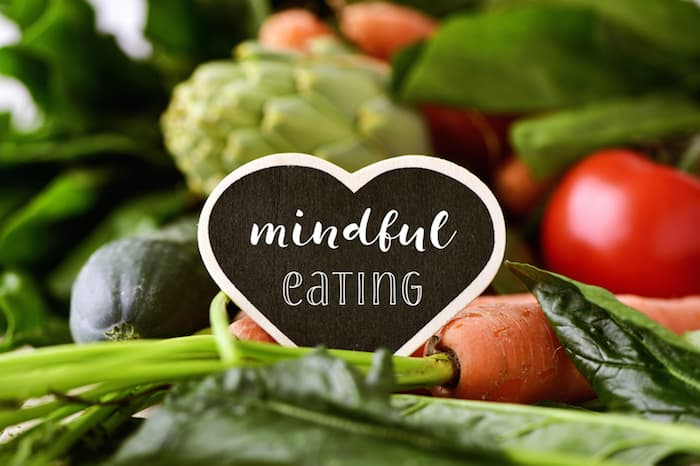- Calls to this hotline are currently being directed to Within Health, Fay or Eating Disorder Solutions
- Representatives are standing by 24/7 to help answer your questions
- All calls are confidential and HIPAA compliant
- There is no obligation or cost to call
- Eating Disorder Hope does not receive any commissions or fees dependent upon which provider you select
- Additional treatment providers are located on our directory or samhsa.gov
Understanding Mindful Eating and Appetite Awareness
Are you aware of how, why, when, and where you eat? Eating mindfully connects us not only to ourselves but to the experience of eating.
Mindful eating also challenges each of us to take a deeper look at our relationships with food, our mind, and our body. Bringing awareness to what drives our appetites will support mending our relationships with food, our mind, and our body.

What is Mindful Eating
Mindful eating consists of a series of questions you explore and put into practice to best nourish your body. These questions represent a cycle of eating that can either control you or give you the freedom to be in charge of your eating experience.
The Mindful Eating Cycle [1]:
- Why do I eat?
- When do I want to eat?
- What do I eat?
- How do I eat?
- How much do I eat?
- Where do I invest my energy?
Rebuilding a trusting relationship with your body means starting to be curious and being open to challenging old habits while practicing new.
Why Do I Eat?
What is promoting you to eat? Is it your body’s internal need for fuel or are external factors driving you?
A mindful eater practices tuning in to their body’s hunger cues. Those not yet in tune may be eating because of external triggers such as pleasure, boredom, pain, anxiety, or you may follow rules to be in control of your body rather than in charge of your body [1].
What is your reason why? ____________________
Remember we don’t always have one why. It’s important to know your why as this is the start of your mindful eating cycle.

When Do I Eat?
When do you want to eat? When your body sends internal cues it’s hungry or do you ignore internal cues and eat based on external factors such what time it is?
Why mindful eaters choose to eat is based on learning what huger feels like and deciphering when a perceived appetite is coming from an outside trigger. Wanting to eat isn’t the same thing as needing to eat [1].
Learning cues that you have been misinterpreting, such as anxiety and fatigue, is part of this process. Along with learning cues that truly are hunger. Here are a couple of true hunger cues:
- Stomach growling
- Difficulty concentrating, mind wandering to food
- Stomach feels empty
- Low energy, lightheaded, headache
- Hangry
What is your why? _____________
What does hunger feel like for you? _______________
Learning to listen to what your body and mind are communicating is a practice that will put you in charge of hearing and choosing how you respond. Try using this hunger and fullness scale [1] next time you choose to eat with a goal to eat when you are between 2-4 on the hunger scale.
- Ravenous: Too hungry to care what you eat. This can put you at an increased risk of overeating.
- Starving: You feel you cannot wait to eat, you must eat now.
- Hungry: Eating would be pleasurable, but you could wait a little longer.
- Hunger Pangs: You’re slightly hungry; may start having thoughts about food.
- Satisfied: You’re content and comfortable. You’re neither hungry nor full; you can’t feel your stomach.
- Full: You can feel the food in your stomach.
- Very Full: Your stomach feels stretched. You may feel tired or sluggish.
- Uncomfortable: Your stomach feels too full.
- Stuffed: You may notice your clothing fitting tighter and you’re feeling very uncomfortable.
- Sick: You’re in pain.

What Do I Eat?
When choosing what to eat we must first explore 3 questions [1]:
- What do I want?
- What do I need?
- What do I have?
When exploring these questions try to challenge good vs. bad thinking. Allow your answers to these questions to not only include nutritionally packed foods, but desired and enjoyed foods as well.
Think about wants related to texture, taste, temperature, etc., needs based on health history, lack of balance, variety, etc., and what you have in the house, based on a budget, or what you can go out to eat or order in [1].
What do you want to eat? _________________
How Do I Eat?
The experience of eating a meal or snack you choose is dependent of how you chose to eat. The next time you eat a meal try to enter the experience with the intention to provide attention to your body and your meal.
Intention means to care for your body through honoring its hunger and meeting its nutritional needs [1].
Attention means to create a space free from distractions allowing for connection to all five senses and hunger and fullness cues [1].
How will you eat your next meal? _____________________

How Much Do I Eat?
Similar to when we choose to eat, we also choose how much we eat, but how do we know when to stop?
If we look back at the hunger and fullness scale, the goal is to honor fullness when you are between a 5 (satisfied) and 6 (full).
To practice exploring what satisfied or full feels like try to non-judgmentally exploring a couple questions [1]:
- How does your stomach feel compared to when you started eating?
- Can you feel food in your stomach?
- Is your food starting to lose its appeal or taste?
- Are you uncomfortable, does it feel painful?
- Are your thoughts drifting from the food?
- Are you energetic or sleepy?
Mindful eaters will sometimes eat past satisfied or full, maybe because food tasted good or they only had a couple bite left, so why not. Not matter the reason, in moment like this you may feel regret, for example “oh man I’m pretty full, definitely could’ve stopped eating a couple bites ago.”
Challenge allowing this to be a moment you can move forward from, rather than sending yourself into a guilt spiral. A guilt spiral can lead some into episodes of binge eating or restriction. Remember mindful eating is a practice and is not meant to be perfect.
How do you know how much to eat? _________________
Related Reading
- Nutrition Counseling
- Foods That Makes You Feel Good
- How a Metabolism Works
- Cues of Being Hungry and Satiety
- Diet Meal Plans
- Regain Weight In Recovery
- Are You Eating Healthy
- Nutrition Assessment and Care Process
- How Your Body Uses Nutrients
Where Do I Invest My Energy?
Last, but not least where does the energy from your meals and snacks go? If your answer is exercise or movement to burn of energy or calories [1], please keep reading.
Think about a full day….you wake up, prepare meals, go to work or school, run around with kids, walk your dog, etc. While you are doing all this, your heart is beating, lungs breathing, mind thinking, and so much more.
We need energy from food to do all everything our bodies need and everything we want. When naming where you invest your energy explore each part of you including your mind, body, spirt, and heart [1].
Where do you invest your energy? _____________
Remember that where you invest your energy will be the start of a new mindful cycle.
References
[1] May, M., MD. (2020). Eat What You Love, Love What You Eat: A Mindful Eating Program to Break Your Eat-Repent-Repeat Cycle (Updated 2020 ed.). Am I Hungry? Publishing.Author: Raylene Hungate, RDN,LD/N

